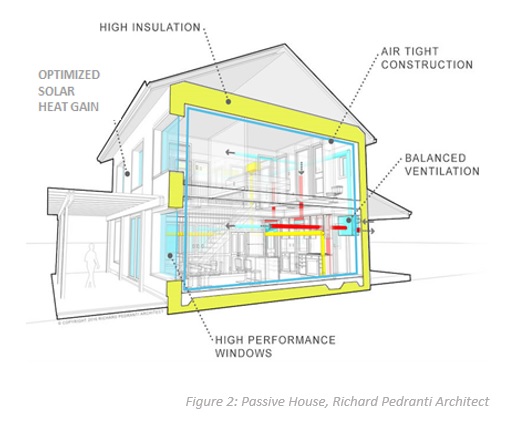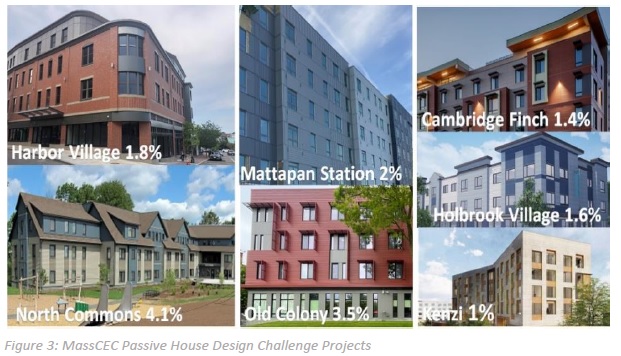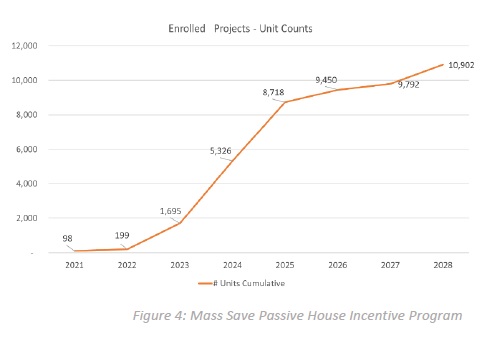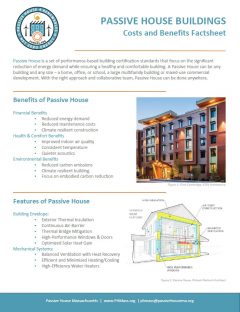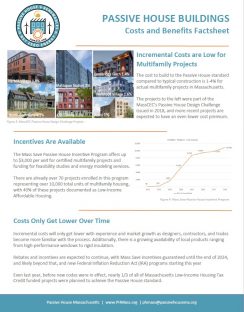Passive House is a performance-based building certification that focuses on the dramatic reduction of energy use for space heating and cooling. It is a set of metrics for energy performance, a certification that can be achieved, and a philosophy for how to design & construct better buildings. Through Passive House, we can deliver a high level of energy savings and carbon reduction for all building types while providing a healthier and more comfortable space to live and work.
A Passive House can be any building – a school, an apartment building, a new residential home or a historical renovation, even an large office skyscraper. Through a thoughtful and integrated design process and a detail oriented approach to construction that prioritizes a well insulated and air-sealed envelope, natural light and solar gain, and highly-efficient HVAC systems, we can create buildings that use over 90% less energy for space conditioning and over 60% less energy overall.
Passive House buildings achieve:
- Drastically lower energy use and operational cost savings
- Healthy air quality from ventilation systems
- Consistent and comfortable room temperatures without air drafts
- Increased natural lighting and quieter acoustic conditions
- A more resilient and comfortable building
On top of all of this, the lower energy demand of Passive House buildings means that the limited energy they do need can be easily provided by solar power, creating a pathway to a net-zero or net-positive building.
To read more about the metrics and certifications that make up the Passive House building standards, please refer to the Passive House Institute U.S. and the Passive House Institute.
To watch recorded videos and webinars from Passive House Massachusetts, visit our video library.
Features of Passive House
Building Envelope
- Exterior Thermal Insulation
- Continuous Air-Barrier
- Thermal Bridge Mitigation
- High-Performance Windows & Doors
- Optimized Solar Heat Gain
Mechanical Systems
- Balanced Ventilation with Heat Recovery
- Efficient and Minimized Heating/Cooling
- High-Efficiency Water Heaters
Benefits of Passive House
Financial Benefits
- Reduced energy demand
- Reduced maintenance costs
- Climate resilient construction
Health & Comfort Benefits
- Improved indoor air quality
- Consistent temperature
- Quieter acoustics
Environmental Benefits
- Reduced carbon emissions
- Climate resilient building
- Focus on embodied carbon reduction
Incremental Costs are Low for Multifamily Projects
The cost to build to the Passive House standard compared to typical construction is 1-4% for actual multifamily projects in Massachusetts.
The projects to the right were part of the MassCEC’s Passive House Design Challenge issued in 2018, and more recent projects are expected to have an even lower cost premium.
Incentives Are Available
The Mass Save Passive House Incentive Program offers up to $3,000 per unit for certified multifamily projects and funding for feasibility studies and energy modeling services.
There are already over 70 projects enrolled in this program representing over 10,000 total units of multifamily housing.
Costs Only Get Lower Over Time
Incremental costs will only get lower with experience and market growth as designers, contractors, and trades become more familiar with the process. Additionally, there is a growing availability of local products ranging from high-performance windows to rigid insulation.
Rebates and incentives are expected to increase as well, with Mass Save incentives guaranteed until the end of 2024, and likely beyond that, and new Federal Inflation Reduction Act (IRA) programs starting this year
Even last year, before new codes were in effect, nearly 1/3 of all of Massachusetts Low-Income Housing Tax Credit funded projects were planned to achieve the Passive House standard. On top of that, 75% of the PHIUS design certified projects in the state are already Affordable Housing developments.
Download our PassiveHouseFactSheet
